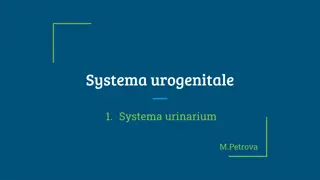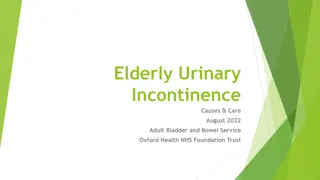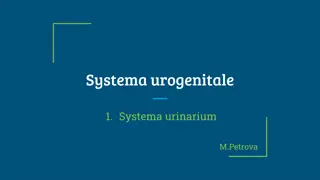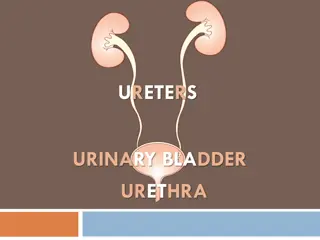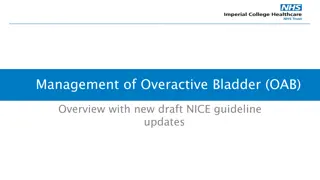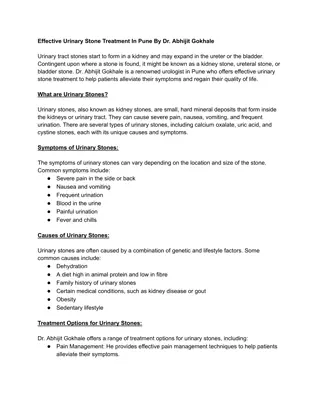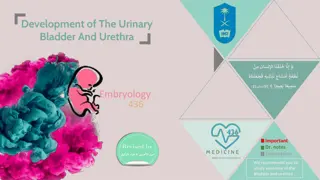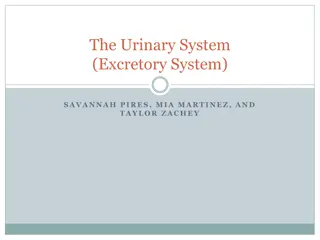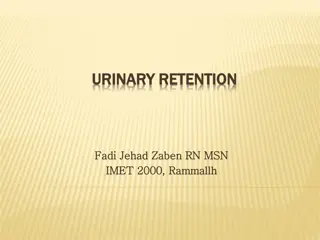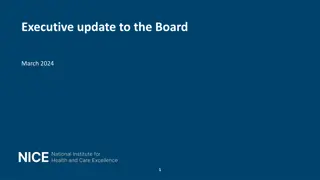Comprehensive Overview of Urinary Incontinence in Women According to NICE Guidance
This December 2017 presentation focuses on urinary incontinence in women, outlining approaches for patients with urge, stress, and mixed incontinence in line with NICE guidance. It covers referral criteria, management strategies, and specialist referral recommendations including the 2-week rule for certain conditions. The session includes learning objectives, history and examination techniques, lifestyle advice, and potential specialist referrals based on specific symptoms.
Download Presentation

Please find below an Image/Link to download the presentation.
The content on the website is provided AS IS for your information and personal use only. It may not be sold, licensed, or shared on other websites without obtaining consent from the author. Download presentation by click this link. If you encounter any issues during the download, it is possible that the publisher has removed the file from their server.
E N D
Presentation Transcript
Urinary Incontinence in Women December 2017 Taken from NICE guidance 2015 Amy Micklethwaite GP Linthorpe surgery
Learning Objectives 1. To have an approach to a patient presenting with urge incontinence in line with nice guidance 2. To have an approach to a patient presenting with stress incontinence in line with nice guidance 3. To have an approach to a patient presenting with mixed incontinence in line with nice guidance 4. To know the 2 week rule criteria for referral in this presenting population 5. To have an idea of what is likely to happen once a patient has been referred, in order to give the patient further information.
Plan for the session 1. Boring slide bit- the NICE guidance 2. Break into groups- approach to a patient presenting with incontinence 3. Back together to discuss this 4. COFFEE aimed 3.10-3.30 5. Cases & quizzes in groups 6. Back together to present our views 7. Feedback 8. Home 16.30
Incontinence- involuntary leakage of urine Types of incontinence
History & Examination Bladder diaries 3 days Specialist referral Urine testing Dipstick & C&S Symptom scoring & QoL assessment OAB/UUI only offer: Lifestyle advice Bladder training Mixed incont: Lifestyle advice Bladder training Pelvic floor muscle training SUI only offer: Lifestyle advice Pelvic floor training Secondary care incl urodynamic testing OAB drug treatment
Specialist referral: 2 week rule Renal tract Cancer >45yrs with frank haematuria without UTI >45yrs with frank haematuria which recurs after UTI treatment. >60yrs with microscopic haematuria AND EITHER dysuria or raised WBC. (Routine referral for >60yrs with recurrent UTIs) Ovarian cancer Ascites Pelvic/abdominal mass Check urgent Ca125 (USS) especially if >50yrs if frequent/persistant: Bloating Early satiety/loss of appetite Pelvic/abdominal pain Increased urinary urge/frequency New IBS Consider if: Unexplained weight loss Fatigue Bowel changes
Specialist Referral Symptomatic pelvic organ prolapse that is visible at or below the introitus. A palpable bladder Persistent bladder or urethral pain (refer urgently if cancer is suspected). A pelvic mass that is clinically benign, such as uterine fibroids. Associated faecal incontinence. Suspected or known neurological disease. A history of previous prolapse surgery, incontinence surgery, pelvic cancer surgery, or previous radiation therapy. Recurrent urinary tract infection. Microscopic (non-visible) haematuria in a woman who is <60 not fulfilling the 2wk rule. Refer to a renal physician if there is also proteinuria or raised serum creatinine levels. Refer non-urgently to a urologist if there is no proteinuria and serum creatinine level is normal. Suspected or known acute kidney injury (AKI) refer to a nephrologist, urgent or same day referral may be required.
History & Examination Bladder diaries 3 days Specialist referral Urine testing Dipstick & C&S Symptom scoring & QoL assessment OAB/UUI only offer: Lifestyle advice Bladder training Mixed incont: Lifestyle advice Bladder training Pelvic floor muscle training SUI only offer: Lifestyle advice Pelvic floor training Secondary care incl urodynamic testing OAB drug treatment
History & Examination Bladder diaries 3 days Specialist referral Urine testing Dipstick & C&S Symptom scoring & QoL assessment OAB/UUI only offer: Lifestyle advice Bladder training Mixed incont: Lifestyle advice Bladder training Pelvic floor muscle training SUI only offer: Lifestyle advice Pelvic floor training Secondary care incl urodynamic testing OAB drug treatment
History & Examination Bladder diaries 3 days Specialist referral Urine testing Dipstick & C&S Symptom scoring & QoL assessment OAB/UUI only offer: Lifestyle advice Bladder training Mixed incont: Lifestyle advice Bladder training Pelvic floor muscle training SUI only offer: Lifestyle advice Pelvic floor training Secondary care incl urodynamic testing OAB drug treatment
OAB/UUI only offer: Lifestyle advice Bladder training 1. Lifestyle advice Reversible causes or contributing factors 2. Bladder training Minimum 6 weeks. Refer to incontinence service.
Condition Mechanism of effect Lower urinary tract May cause inflammation with activation of sensory afferent innervation. Urinary tract infection Obstruction May contribute to detrusor overactivity and urinary retention. Reduced functional bladder capacity and urinary retention can result. Impaired bladder contractility Bladder abnormalities causing inflammation (for example tumours, calculi, interstitial cystitis) May precipitate detrusor overactivity. Oestrogen deficiency Atrophic vaginitis and urethritis may contribute to symptoms. Leakage of urine into the proximal urethra may precipitate urgency. Ability to inhibit detrusor muscle by sphincter contraction may be diminished. Sphincter weakness Neurological Brain: stroke, dementia (including Alzheimer's disease), Parkinson's disease, multiple sclerosis Higher cortical inhibition of the bladder is impaired, causing detrusor overactivity of neurogenic origin. Spinal cord: multiple sclerosis, cervical or lumbar stenosis or disc herniation, spinal cord injury Neurogenic detrusor overactivity or urinary retention can result. Urinary retention and low functional bladder capacity can result. Peripheral innervation: diabetic neuropathy, nerve injury Systemic Volume overload can contribute to urinary frequency and nocturia when the person is lying down. Congestive heart failure, venous insufficiency with oedema Poor blood glucose control can contribute to osmotic diuresis and polyuria. Polyuria may result. Diabetes mellitus Hypercalcaemia Functional and behavioural disorders Excess intake of caffeine, alcohol, or fluids Constipation Impaired mobility or dexterity (for example joint disease or muscle weakness) Polyuria and urinary frequency can result. Faecal impaction can contribute to symptoms. Interferes with toileting ability and may precipitate urgency incontinence. Chronic anxiety and learned voiding dysfunction can cause symptoms of overactive bladder. Psychological conditions
Lifestyle advice Reducing caffeine intake improve urgency and frequency Fluid intake avoid drinking excessive amounts or reduced amounts The recommended daily intake is six to eight glasses of water. Avoiding alcohol, citrus drinks, fizzy drinks. Weight loss - if BMI >30 kg/m2 Smoking if appropriate chronic cough may contribute to stress urinary incontinence
History & Examination Bladder diaries 3 days Specialist referral Urine testing Dipstick & C&S Symptom scoring & QoL assessment OAB/UUI only offer: Lifestyle advice Bladder training Mixed incont: Lifestyle advice Bladder training Pelvic floor muscle training SUI only offer: Lifestyle advice Pelvic floor training Secondary care incl urodynamic testing OAB drug treatment
OAB drug treatment Anticholinergic (antimuscarinic) Oxybutynin (immediate release) Tolterodine (immediate release) Darifenacin (once daily preparation) can be used first-line. transdermal oxybutynin for women who are unable to take oral medication DO NOT offer immediate release oxybutynin to frail older women due to the risk of impairment of daily functioning and delirium Mirabegron Add in topical vaginal oestrogen if atrophy present Consider adding desmopressin if troublesome nocturia
OAB drug treatment continued Counsel patients Takes time to work Side effects- anticholinergic load, dry mouth, constipation, retention if poor bladder emptying May need to increase dose Can stay on longterm Review at 4weeks: If okay review at 12 weeks then annually (or 6m or elderly If not helping, try alternative antimuscarinic, consider mirabegron or referral
History & Examination Bladder diaries 3 days Specialist referral Urine testing Dipstick & C&S Symptom scoring & QoL assessment OAB/UUI only offer: Lifestyle advice Bladder training Mixed incont: Lifestyle advice Bladder training Pelvic floor muscle training SUI only offer: Lifestyle advice Pelvic floor training Secondary care incl urodynamic testing OAB drug treatment
Secondary care incl urodynamic testing If conservative treatments fail or if the woman wants further management, consider referring to urology/gynae for: Intermittant self catheterisation Botulinum toxin A Percutaneous sacral nerve stimulation Percutaneous posterior tibial nerve stimulation if the woman does not want botulinum toxin A or sacral nerve stimulation Augmentation cystoplasty Urinary diversion
History & Examination Bladder diaries 3 days Specialist referral Urine testing Dipstick & C&S Symptom scoring & QoL assessment OAB/UUI only offer: Lifestyle advice Bladder training Mixed incont: Lifestyle advice Bladder training Pelvic floor muscle training SUI only offer: Lifestyle advice Pelvic floor training Secondary care incl urodynamic testing OAB drug treatment
SUI only offer: Lifestyle advice Pelvic floor training 1. Lifestyle advice Caffeine Fluid intake Weight loss Smoking if this is appropriate eg chronic cough which may contribute to stress urinary incontinence Give advice on reversible causes or contributing factors- as before
Lifestyle advice- self help info NHS Choices provides online information for people with urinary incontinence. The Bladder and Bowel Foundation has a helpline (telephone 01536 533 255) and provides a range of resources on their website (www.bladderandbowelfoundation.org).
2. Pelvic floor training Offer referral for a programme of supervised pelvic floor muscle training (PFMT) continence nurses locally Should last at least 3 months >8 pelvic floor muscle contractions >3x/day. Patient info at www.csp.org.uk (pdf) Pads & toileting aids should only be offered whilst awaiting treatment, if all treatment failed or severe cognitive or mobility impairment.
History & Examination Bladder diaries 3 days Specialist referral Urine testing Dipstick & C&S Symptom scoring & QoL assessment OAB/UUI only offer: Lifestyle advice Bladder training Mixed incont: Lifestyle advice Bladder training Pelvic floor muscle training SUI only offer: Lifestyle advice Pelvic floor training Secondary care incl urodynamic testing OAB drug treatment
Secondary care If conservative treatments fail or if the woman wants further management, consider: Referring to gynae/urology Treatment options in secondary care include synthetic mid-urethral tape, colposuspension, autologous rectus fascial sling, intramural urethral bulking agents, or an artificial urinary sphincter. Offer duloxetine as a second-line treatment, but only if the woman prefers drug to surgical treatment or is not suitable for surgical treatment.
References http://cks.nice.org.uk/incontinence-urinary- in-women
Into pairs- Approach to a patient presenting with incontinence Condition Mechanism of effect Lower urinary tract May cause inflammation with activation of sensory afferent innervation. Urinary tract infection Obstruction May contribute to detrusor overactivity and urinary retention. Reduced functional bladder capacity and urinary retention can result. Impaired bladder contractility Bladder abnormalities causing inflammation (for example tumours, calculi, interstitial cystitis) May precipitate detrusor overactivity. Oestrogen deficiency Atrophic vaginitis and urethritis may contribute to symptoms. Leakage of urine into the proximal urethra may precipitate urgency. Ability to inhibit detrusor muscle by sphincter contraction may be diminished. Sphincter weakness Neurological Brain: stroke, dementia (including Alzheimer's disease), Parkinson's disease, multiple sclerosis Higher cortical inhibition of the bladder is impaired, causing detrusor overactivity of neurogenic origin. Spinal cord: multiple sclerosis, cervical or lumbar stenosis or disc herniation, spinal cord injury Neurogenic detrusor overactivity or urinary retention can result. Urinary retention and low functional bladder capacity can result. Peripheral innervation: diabetic neuropathy, nerve injury Systemic Volume overload can contribute to urinary frequency and nocturia when the person is lying down. Congestive heart failure, venous insufficiency with oedema Poor blood glucose control can contribute to osmotic diuresis and polyuria. Polyuria may result. Diabetes mellitus Hypercalcaemia Functional and behavioural disorders Excess intake of caffeine, alcohol, or fluids Constipation Impaired mobility or dexterity (for example joint disease or muscle weakness) Polyuria and urinary frequency can result. Faecal impaction can contribute to symptoms. Interferes with toileting ability and may precipitate urgency incontinence. Chronic anxiety and learned voiding dysfunction can cause symptoms of overactive bladder. Psychological conditions



